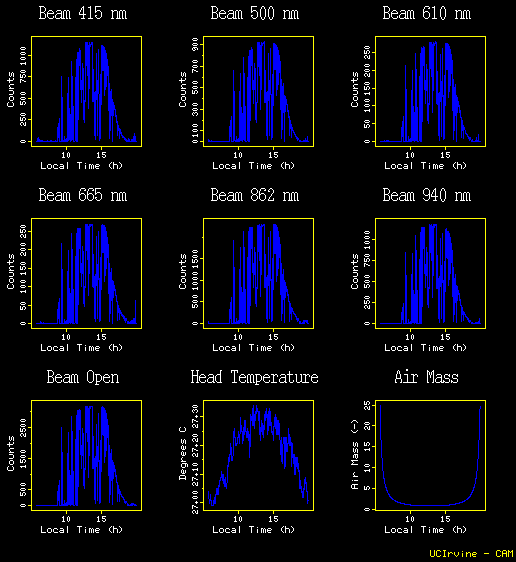
As of April 2000, a Yankee Environmental Systems (YES) multi-filter rotating shadowband radiometer (or MFRSR) has been making measurements of sunlight on the roof of Reines Hall on the University of California at Irvine campus. These measurements are used to derive (vertically integrated column) ozone and aerosol above UCI.
| MFRSR Background | Photographs of UCI MFRSR |
| Data Analysis | Daily Irradiance | Ozone Time Series | Aerosol Time Series | Archived Ascii Data |
| Atmopsheric Radiation Measurement Program MFRSR Page | ASRS Solar Group's MFRSR Page |
Daily plot of direct beam irradiance
These are currently uncalibrated.

Ozone time series from May 12, 2000
This shows ozone column in Dobson Units, DU (1 DU=2.7x1016molecules/cm2), as a function of local time (about 8:30am to 4:30pm). The measurement indicate roughly 315 DU (compared with 307 DU from the TOMS satellite)
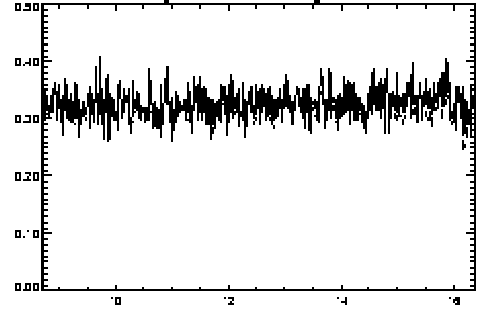
The Multi-Filter Rotating Shadowband Radiometer
The MFRSR has seven diodes which measure downwelling visible and near-IR solar irradiance. Six of these diodes are filtered such that transmission is limited to a 10 nm window; the seventh measures the entire spectrum over which silicon is sensitive. The six interference filters are centered at (nominal wavelengths only):
MFRSR Photographs
The MFRSR is located on the roof of Physcial Sciences II on the
University of California, Irvine campus
(33.68oN, 117.75oW)
Analysis and Retrieval of Aerosol and Ozone
The means by which the vertical column of ozone and aerosol
is retrieved is Langley analysis.
The direct solar beam as it passes through our atmosphere is attenuated
according to the Beer-Bouguer-Lambert law (a.k.a. Beer's law),
where AMF is the airmass factor which describes the enhancement of
the slant path over the vertical, and OD is the vertical optical
depth of the atmosphere. Taking the natural logarithm of both sides,
which is of the form
such that a=ln(Io) represents the y-intercept
and b=OD represents the slope. Thus, if the AMF is plotted
versus the logrithm of the irradiance (at a given wavelength)
for many data points throughout
a morning or afternoon, a straight line should result. Linear
regression performed on this data will give the
slope and intercept, which amount to the logrithm of the extra-terrestrial
irradiance and the vertical optical depth.
The vertical optical depth of the atmopshere
includes components from molecular and aerosol scattering and,
depending on the channel,
may also include absorption by ozone or water vapour.
The airmass factor can be determined from the solar zenith angle
(which is a funciton of latitude, season, and time of day).
If SZA represents the solar zenith angle, then the airmass factor is,
as long as the sun is fairly high in the sky
(i.e., SZA<70o; AMF<3).
Otherwise, a modified expression should be used which accounts for the
sphericity of the Earth,
where SZA is in radians (Kasten and Young, 1989).
Ozone & Aerosol Optical Depth
The primary purpose of sunphotometers is measurement of the
aerosol optical depth, which is calculated through,
We first use a channel (or wavelength) in which there is no
significant absorption by O3 and H2O
(i.e., ODO3=ODH2O=0).
The two channels are 415 and 868 nm. The Rayleigh optical depth
can be calculated based solely on the pressure of the measurement site, P,
using,
where Po=1013.24 mbar is standard surface pressure and wavelength
is in nm (Hansen and Travis, 1974).
The method used to analysis these data is that of Alexandrov
et al. which solves for aerosol optical depth, ozone column,
NO2 column,
References
1. Bigelow, D. S., J. R. Slusser, A. F. Beaubien, and J. H. Gibson,
The USDA ultraviolet radiation monitoring program, Bulletin of the
American Meterological Society, 79, 601-615, 1998.
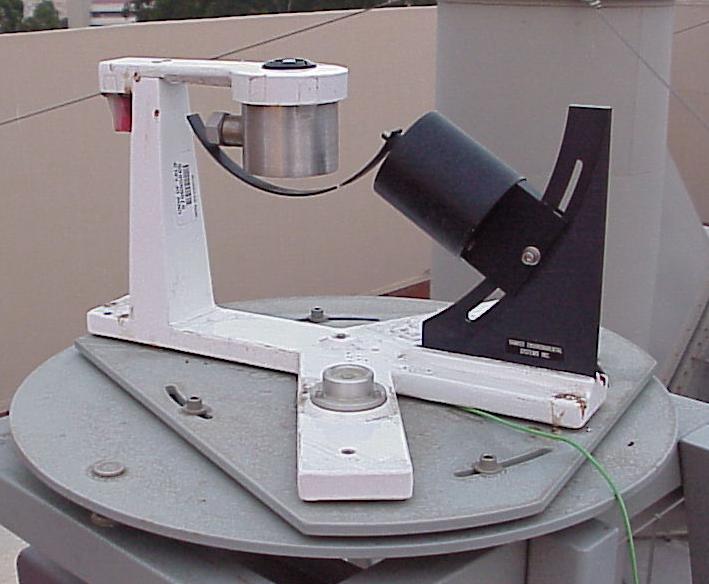
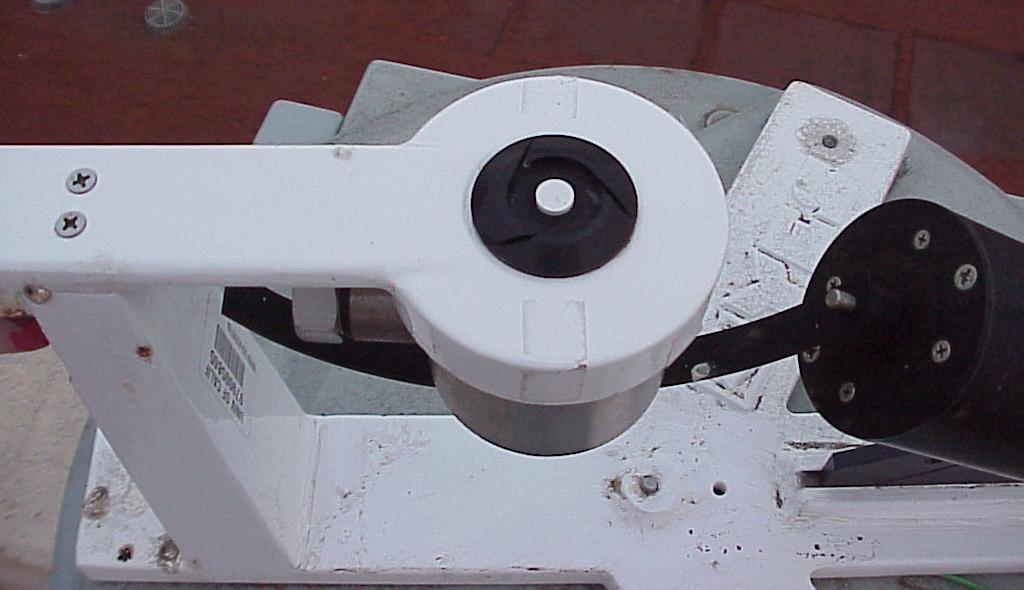
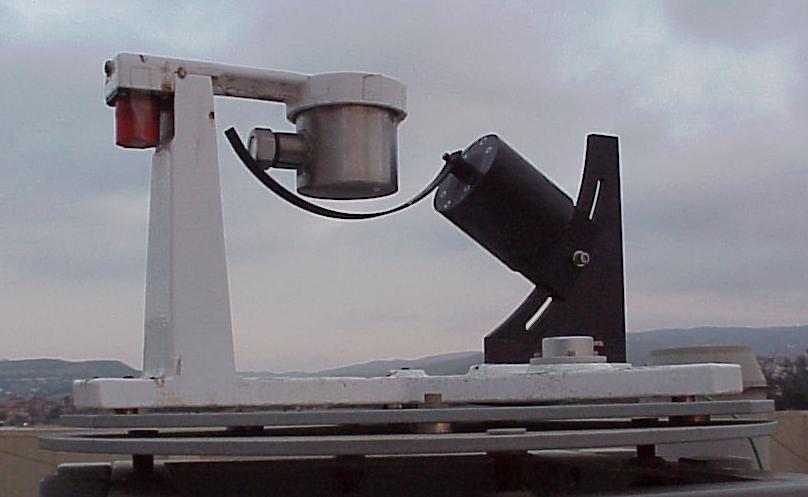
2. Harrison, L., J. Michalsky, and J. Berndt, Automated multifilter
rotating shadow-band radiometer: an instrument for optical depth and
radiation measurements, Applied Optics, 33, 5118-5125, 1994.
3. Harrison, L. and J. Michalsky, Objective algorithms for the retrieval
of optical depths from ground-based measurements, Applied Optics,
33, 5126-5132, 1994.
4. Hansen J. E. and L. D. Travis, Light scattering in planetary atmospheres,
Space Science Reviews, 16, 527-610, 1974.
5. Kasten and Young, Revised optical air mass tables and approximation
formula, Applied Optics, 28, 4735-4738, 1989.
6. Alexandrov, M. D., A. A. Lacis, B. E. Carlson, and B. Cairns,
Remote sensing of atmospheric aerosols, nitrogen dioxide, and ozone
by means of multi-filter rotating shadow-band radiometer, in
Remote Sensing of Clouds and Atmosphere, J. Russell and C. Serio,
Editors, Proc. SPIE 3867, 156-170, 1999.
![]() Return to Research Page
Return to Research Page ![]() Return to Homepage
Return to Homepage